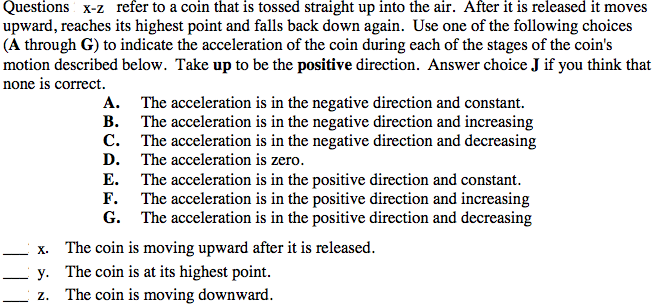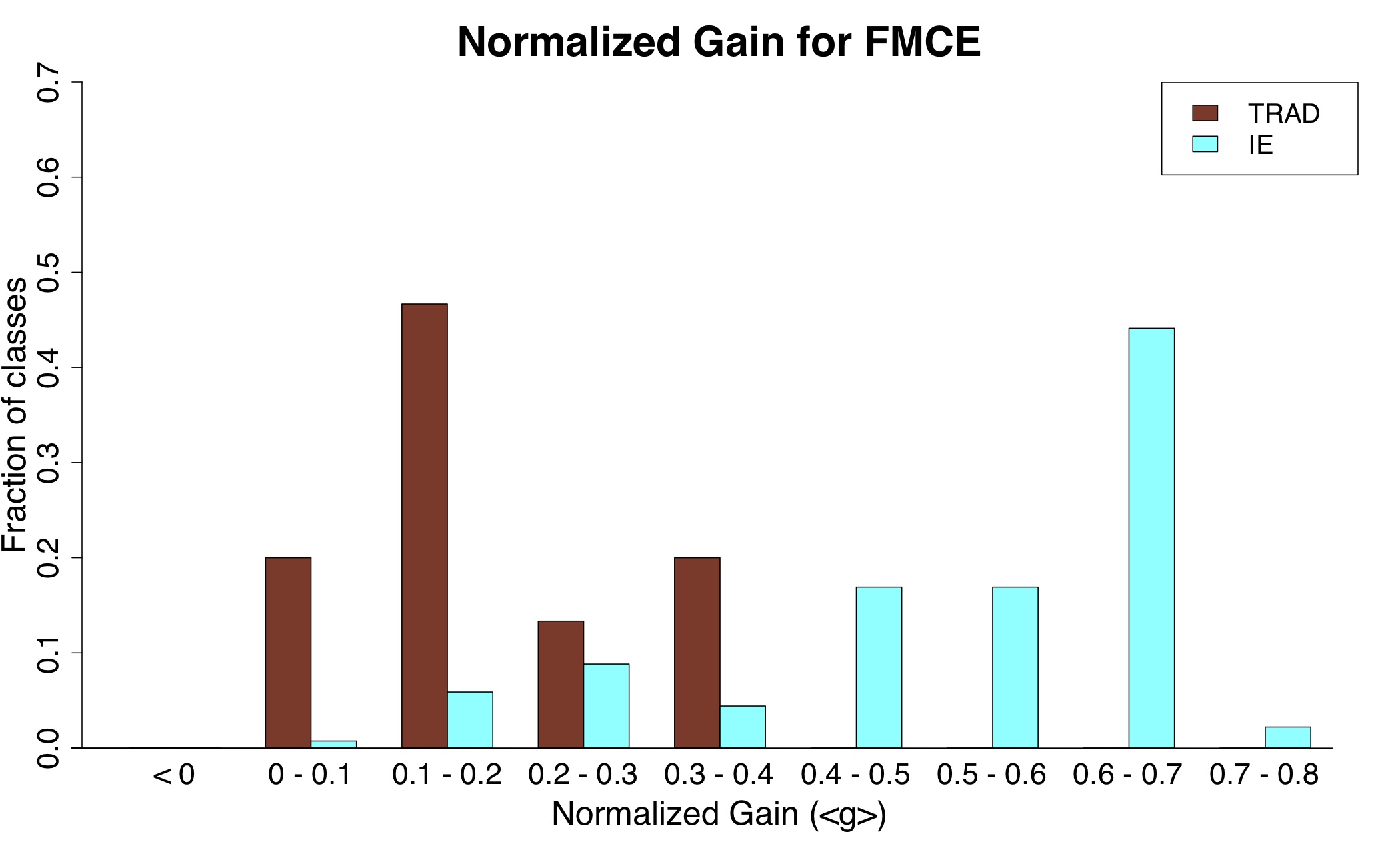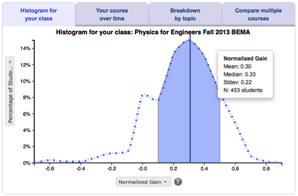Developed by Ron Thornton and David Sokoloff
| Purpose | To assess students' understanding of Newtonian mechanics. |
|---|---|
| Format | Pre/post, Multiple-choice |
| Duration | 35 min |
| Focus | Mechanics Content knowledge (kinematics, forces, energy, graphing) |
| Level | Intro college, High school |
Sample questions from the FMCE:
FMCE Implementation and Troubleshooting Guide
Everything you need to know about implementing the FMCE in your class.
Login or register to download the implementation guide.
more details
This is the highest level of research validation, corresponding to all seven of the validation categories below.
Research Validation Summary
Based on Research Into:
- Student thinking
Studied Using:
- Student interviews
- Expert review
- Appropriate statistical analysis
Research Conducted:
- At multiple institutions
- By multiple research groups
- Peer-reviewed publication
The multiple-choice questions on the FMCE were developed based on student interviews, responses to open-ended versions of the questions and expert review. Statistical analyses of reliability and consistency were conducted and the FMCE was found to be reliable and consistent between test and re-test. A factor analysis found that questions were clustered around three factors, which were named “Newton’s first and second law, including acceleration,” “Newton’s third law,” and “velocity concept”. This means that students’ view these groups of questions as strongly related. The FMCE has been used to compare the effectiveness of many different teaching methods and the results published in over 20 peer-reviewed publications. It has been administered at over 15 different institutions to over 20,000 students in both algebra and calculus-based introductory physics courses.
References
- S. Bonham, Latent Response Times and Cognitive Processing on the FMCE, presented at the Physics Education Research Conference 2008, Edmonton, Canada, 2008.
- K. Cummings, J. Marx, R. Thornton, and D. Kuhl, Evaluating innovation in studio physics, Am. J. Phys. 67 (S1), S38 (1999).
- G. Davenport, The Reliability of the Force and Motion Conceptual Evaluation, Masters, University of Maine, 2008.
- P. Eaton, B. Frank, and S. Willoughby, Detecting the influence of item chaining on student responses to the Force Concept Inventory and the Force and Motion Conceptual Evaluation, Phys. Rev. Phys. Educ. Res. 16 (2), 020122 (2020).
- N. Finkelstein and S. Pollock, Replicating and understanding successful innovations: Implementing tutorials in introductory physics, Phys. Rev. ST Phys. Educ. Res. 1 (1), (2005).
- R. Henderson, J. Stewart, and A. Traxler, Partitioning the gender gap in physics conceptual inventories: Force Concept Inventory, Force and Motion Conceptual Evaluation, and Conceptual Survey of Electricity and Magnetism, Phys. Rev. Phys. Educ. Res. 15 (1), 010131 (2019).
- R. Henderson, C. Zabriskie, and J. Stewart, Rural and First Generation Performance Differences on the Force and Motion Conceptual Evaluation, presented at the Physics Education Research Conference 2018, Washington, DC, 2018.
- D. Hewagallage, E. Christman, and J. Stewart, Examining the relation of high school preparation and college achievement to conceptual understanding, Phys. Rev. Phys. Educ. Res. 18 (1), 010149 (2022).
- D. Hewagallage, J. Stewart, and R. Henderson, Differences in the predictive power of pretest scores of students underrepresented in physics, presented at the Physics Education Research Conference 2019, Provo, UT, 2019.
- C. Hoellwarth and M. Moelter, The implications of a robust curriculum in introductory mechanics, Am. J. Phys. 79 (5), 540 (2011).
- C. Hoellwarth, M. Moelter, and R. Knight, A direct comparison of conceptual learning and problem solving ability in traditional and studio style classrooms, Am. J. Phys. 73 (5), 459 (2005).
- M. Ishimoto, Evaluation of the Translated Version of the FMCE, presented at the Physics Education Research Conference 2013, Portland, OR, 2013.
- L. Kost, S. Pollock, and N. Finkelstein, Unpacking Gender Differences in Students’ Perceived Experiences in Introductory Physics, presented at the Physics Education Research Conference 2009, Ann Arbor, Michigan, 2009.
- L. Kost-Smith, S. Pollock, and N. Finkelstein, Gender disparities in second-semester college physics: The incremental effects of a "smog of bias", Phys. Rev. ST Phys. Educ. Res. 6 (2), 020112 (2010).
- K. Louis, B. Ricci, and T. Smith, Determining a hierarchy of correctness through student transitions on the FMCE, presented at the Physics Education Research Conference 2018, Washington, DC, 2018.
- S. Pollock, Transferring Transformations: Learning Gains, Student Attitudes, and the Impacts of Multiple Instructors in Large Lecture Courses, presented at the Physics Education Research Conference 2005, Salt Lake City, Utah, 2005.
- S. Ramlo, Validity and reliability of the force and motion conceptual evaluation, Am. J. Phys. 76 (9), 882 (2008).
- S. Ramlo, The Force and Motion Conceptual Evaluation, ERIC Database, Report No. ED471542, 2002.
- M. Sharma, I. Johnston, H. Johnston, K. Varvell, G. Robertson, A. Hopkins, C. Stewart, I. Cooper, and R. Thornton, Use of interactive lecture demonstrations: A ten year study, Phys. Rev. ST Phys. Educ. Res. 6 (2), 020119 (2010).
- T. Smith, Telling new stories by reanalyzing old data: FMCE edition, presented at the Physics Education Research Conference 2015, College Park, MD, 2015.
- T. Smith, K. Gray, K. Louis, B. Ricci, and N. Wright, Showing the dynamics of student thinking as measured by the FMCE, presented at the Physics Education Research Conference 2017, Cincinnati, OH, 2017.
- T. Smith, K. Louis, B. Ricci, and N. Bendjilali, Quantitatively ranking incorrect responses to multiple-choice questions using item response theory, Phys. Rev. Phys. Educ. Res. 16 (1), 010107 (2020).
- T. Smith and M. Wittmann, Comparing three methods for teaching Newton’s third law, Phys. Rev. ST Phys. Educ. Res. 3 (2), 020105 (2007).
- T. Smith and M. Wittmann, Applying a resources framework to analysis of the Force and Motion Conceptual Evaluation, Phys. Rev. ST Phys. Educ. Res. 4 (2), 020101 (2008).
- R. Thornton, Measuring and Improving Student Mathematical Skills for Modeling, presented at the GIREP Conference 2006: Modeling in Physics and Physics Education, Amsterdam, Netherlands, 2006.
- R. Thornton, D. Kuhl, K. Cummings, and J. Marx, Comparing the force and motion conceptual evaluation and the force concept inventory, Phys. Rev. ST Phys. Educ. Res. 5 (1), 010105 (2009).
- R. Thornton and D. Sokoloff, Assessing student learning of Newton's laws: The Force and Motion Conceptual Evaluation and the Evaluation of Active Learning Laboratory and Lecture Curricula, Am. J. Phys. 66 (4), 338 (1998).
- J. Von Korff, B. Archibeque, K. Gomez, T. Heckendorf, S. McKagan, E. Sayre, E. Schenk, C. Shepherd, and L. Sorell, Secondary analysis of teaching methods in introductory physics: A 50 k-student study, Am. J. Phys. 84 (12), (2016).
PhysPort provides translations of assessments as a service to our users, but does not endorse the accuracy or validity of translations. Assessments validated for one language and culture may not be valid for other languages and cultures.
| Language | Translator(s) | |
|---|---|---|
| Indonesian | Purwoko Haryadi Santoso |  |
| Japanese | Michi Ishimoto |  |
| Spanish | Olivier Espinosa and Hugo Alarcon |  |
If you know of a translation that we don't have yet, or if you would like to translate this assessment, please contact us!

Login or register to download the answer key and an excel scoring and analysis tool for this assessment.
Score the FMCE on the PhysPort Data Explorer
With one click, you get a comprehensive analysis of your results. You can:
- Examine your most recent results
- Chart your progress over time
- Breakdown any assessment by question or cluster
- Compare between courses
| Typical Results |
|---|
This figure from Von Korff et al. 2016 presents typical FMCE normalized gain scores for two different teaching method types, interactive engagement and traditional lecture, for US and Canadian college students at a wide variety of institution and class types. Courses taught using interactive engagement methods have higher normalized gains than those taught using traditional lecture. These results are from a metaanalysis of FMCE gains for 14,000 students in 150 classes, published in 15 papers. The FMCE has also been given to tens of thousands of students in high school and outside of the US, who are not included in this study. The average normalized gain is 0.52 for interactive engagement and 0.19 for traditional lecture.
|
The latest version of the FMCE, released in 1999, is called v99 and has 47 questions. The original version, v98, published in Thornton and Sokoloff (1998), is the same as the 1999 version except that it is missing the last 4 questions, which are about energy. Most scoring schemes do not score the last 4 questions.
Variation
|
|
Force and Motion Conceptual Evaluation OriginalContent knowledge Mechanics (kinematics, forces, energy, graphing)Intro college, High school Pre/post, Multiple-choice |






